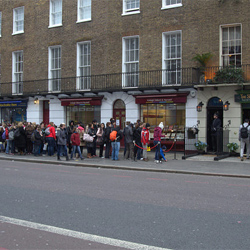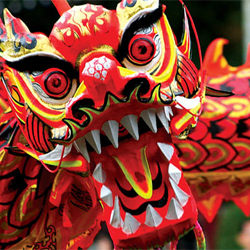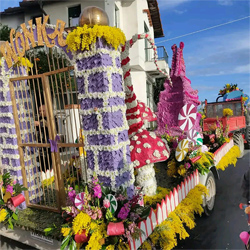After finally putting the Christmas holidays behind us and while waiting for the
next big religious celebration of Easter here in Italy, we open the Festival season of Carnival, which begins the Sunday of Septuagesima. Despite its name – which means seventy – it falls exactly nine weeks before Easter Sunday and Carnival ends on March 1st this year 2017, on Ash Wednesday, the day after Fat Tuesday.Fat Tuesday is the last day of Carnival celebrations and it’s the most eventful one, the day when the biggest parades take place all over the country.I love this time of the year because, following the gray cold months of the winter season, the streets become filled with colors just before spring comes along and everybody seems suddenly more festive and cheerful and ready to leave the winter sadness behind. The Carnival’s motto is
“a Carnevale ogni scherzo vale” which is a rhyme for ‘around Carnival time any joke goes’ since this is a time of pranks and practical jokes.

Colorful streamers in the streets during Carnival
The Carnival in Italy is a tradition that is repeated from year to year and it is celebrated with floats parades, evoking those of the very famous Brazilian Carnival. Masks and costumes are typical of this time of year and so are confetti and colored streamers which are thrown on the streets and at private parties.The Carnival festivities are very famous in Italy due to their historical traditions and the program of events in every region is very rich. Events and concerts enliven the streets during the entire month of February and some typical costumes and masks from Italy are Arlecchino, Balanzone, Pulcinella, Pantalone, Gianduja and Columbine and they all have historical origins and unique clothes.The Italian masks have a long history, sometimes literary, and their protagonists come from the theatrical world and from regional tales. Every city has its typical mask: Arlecchino is from Venice, with its black mask and his multicolored costume decorated with lozenges, Pulcinella is from Naples, his face half white and half black and his white pajamas, Balanzone from Bologna is elegantly dressed and so on…but nowadays all masks appear on the streets of every Italian city during Carnival without regional boundaries.
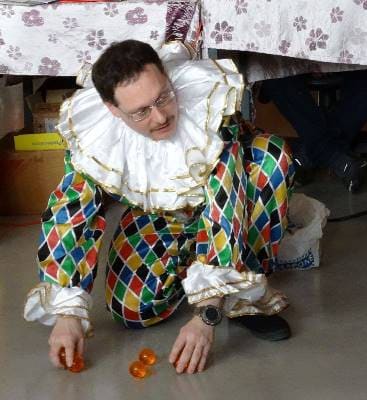
Arlecchino (Harlequin) is a traditional Italian costume
Carnival is a difficult time to interpret but it certainly is a magical time of revelry, during which you forget life problems.In the liturgical Christian calendar it falls between the Epiphany (Three Kings’ Day, on January 6th) and Lent. Regarding the etymology of the word the most reliable hypothesis relates to the Latin Carnival
“carnem levare” that refers to the religious abstention from meat consumption prior to Easter. Paradoxically, the Carnival period is characterized by enjoyment and pleasure coming from food, drink and partying which is the opposite of what its name stands for. Others think that its origin is placed far back in time: the scholars trace the birth of the Carnival to the pagan celebration of Saturnalia. During Roman time, the Romans used to celebrate the anniversary of the construction of the temple dedicated to the god Saturn and poured into the streets singing and praising the father of all gods. In Liguria, my region, the Carnival time is celebrated with parades of floats organized throughout the month of February.The involvement is strong and the Community’s commitment is total and often binds with humanitarian initiatives of solidarity such as fundraising events and the promotion of school initiatives.It is worth noting that, with the exception of Venice, the biggest cities don’t offer events for Carnival and they are limited to the small Italian provinces which take advantage of this time of the year to forcefully assert their cultural identity, quite different from the urban culture and take for a moment the scene after being ignored by tourists for the rest of the year. The floats are usually decorated with flowers and streamers and the costumed participants riding on the floats often throw candies and prizes to the crowd while the float files past the streets.
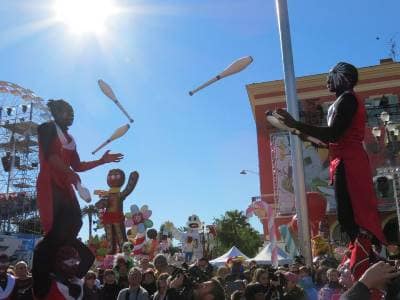
Carnival floats file past the streets
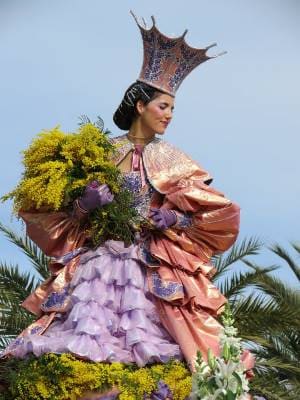
Floats are often decorated with flowers
During Carnival people organize many costume parties at home or at the local schools where, for an afternoon, children can pretend to be pirates, princesses, fairies, witches or cartoon characters while playing fun games and banging on
pentolacce (piñatas) to win candies and chocolates.A
pentolaccia is a container often made of papier-mâché which is decorated with colorful decorations and filled with small toys or candies or both. The children are blindfolded and they try to break the piñata with a stick to win as many candies as possible. Many adults also organize costume parties during this time of the year and play games with prizes just like children do.If you ever decide to organize a carnival party at home, remember not to use confetti because they get just about everywhere and you’ll still be finding some around your house many months later!
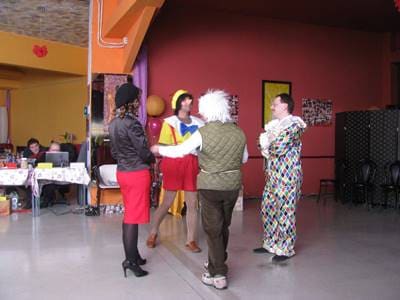
Adults become children during Carnival time
There are a lot of treats prepared in the bakeries and pastry shops all over Italy just around Carnival time and everywhere one can find the pastries called
chiacchiere (whose name means gossip), deep fried sweet fritters made with flour and butter and covered with powdered sugar. Their shape changes according to the region and they sometimes also come filled with apricot jam or Nutella spread.Some Carnival time treats are exclusively regional or even limited to some cities, among them are my favorite
‘Ravioli dolci di carnevale’; these Carnival ravioli look exactly like the pasta ones but they are made with marzipan (almond paste) and filled with chocolate paste, sprinkled with grated almonds (which look like parmesan cheese) and topped with some strawberry jam (which looks like tomato sauce)…The result is a yummy (and extremely caloric) treat which is sold in the best pastry shops of my city only during the weeks leading to Fat Tuesday.
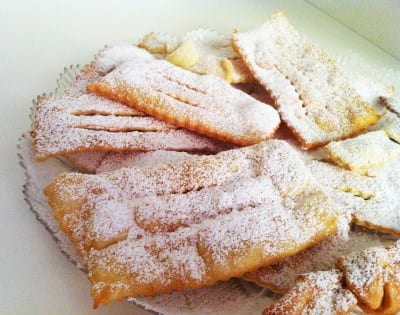
Carnival’s chiacchiere fritters
Here is my mother’s recipe for the typical
Chiacchiere di Carnevale so you can try to make them yourself back home and get some Carnival spirit into you!You will need these ingredients:250 grams of flour, 1 egg, 25 grams of butter, 50 grams of milk, 20 grams of sugar, the peel of an organic lemon grated, a pinch of salt, 2 grams of yeast, oil to fry, powdered sugar for the decoration. And this is how you prepare them:Form a mound of flour then add the egg in the center together with the softened butter, the sugar, a pinch of salt, the lemon zest and the yeast.Gradually begin to knead by slowly adding in the milk. Once the mixture is homogenous and does not become sticky make it in the shape of a ball, wrap it with plastic wrap and put it to rest in your refrigerator for at least thirty minutes.After this time, take the dough from the fridge and smooth it with a rolling pin into a thin sheet of about 3.5 millimeters.Using a pastry wheel cut the dough into medium-sized rectangles starting from the center.Heat up some cooking oil in a pan and bring to a boil then fry your
chiacchiere for a few minutes until golden and crispy on both sides.Once ready, drain them on paper towel to remove the excessive oil. Sprinkle the fritters with powdered sugar and let them cool down. The
chiacchiere are good eaten warm or at room temperature. Enjoy!



















